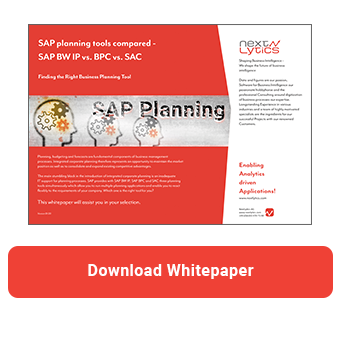We are in the middle of a digital transformation characterized by rapid changes and increased customer expectations. In these times, the question is no longer whether a planning tool is needed, but rather which tool it should be.
SAP is sending two candidates into the race: SAP Business Planning and Consolidation (SAP BPC) and SAP Analytics Cloud (SAC). These tools enable users to create, control and maintain planning applications largely independently. Both tools have an intuitive user interface and a low technical entry hurdle. The business department becomes more independent from the IT department and is able to adapt the planning process faster and more flexibly to the constantly changing market requirements.
But which tool is right for you? Should you choose SAP Business Planning and Consolidation or SAP Analytics Cloud? This article supports you in your decision making.
The advantages of BPC
SAP BPC enables you to implement both central and area-specific planning processes. With SAC, on the other hand, the focus is more on flexible planning. For central planning applications, the tool is only conditionally suitable.
Another advantage of SAP Business Planning and Consolidation is the integrated consolidation function including the IFRS Starter Kit. You cannot perform consolidation in SAP Analytics Cloud.
Furthermore, BPC offers more customizing possibilities than SAC. Since it is an on-premises application, the range of customizing possibilities is practically endless. SAC, on the other hand, offers fewer possibilities to intervene in the behavior of the system, since it is a cloud application.
When customizing BPC, you can use languages such as ABAP and SQL, which are strongly represented in the database environment. With SAC you work with JavaScript. This language is less common in the business warehousing ecosystem.

What are the advantages of SAC?
SAP Business Planning and Consolidation appeals to users from the business department, as it also supports flexible planning scenarios. SAP Analytics Cloud consistently pursues this approach and, in addition to ad-hoc planning scenarios, offers new technologies such as AI and machine learning to support the user in decision-making.
Compared to BPC, SAC is more flexible and gives the business department more control. Although independent ad-hoc reporting is also possible in BPC, SAC takes reporting to a new level through machine learning functions such as Smart Discovery.
Another advantage of SAC is the short implementation time. Since it is a SaaS offering, installation, operation and maintenance are not required. BPC, on the other hand, requires development by the IT department, which may result in a longer implementation period. It is true that the IT department must also be involved when developing a SAC planning application. However, IT-affine employees can be trusted to make adjustments themselves, which would otherwise have to be made by IT as a change request.
In addition, you can rely on centralized updates from SAC. You do not need to worry about maintenance. With BPC, you have to perform updates manually, which is also associated with system downtimes.
And while BPC requires investment costs for the hardware, SAC can be paid with balance sheet-neutral monthly installments. BPC On-Premises may run on old hardware. SAC, on the other hand, guarantees state-of-the-art technology.
Since no hardware is required to operate SAC, it can be scaled very easily. While on-premises applications such as BPC may require new hardware to be purchased, SAC is easy to scale.
Finally, it should be emphasized that SAC represents a central front-end for reporting, dashboarding and planning. You do not need any other tools for the respective areas of application and SAC as a portal solution for your reporting. Since Analysis for Office 2.7 you can even use Excel for SAP Analytics Cloud.
Planning Tools compared - SAP BW IP vs. BPC vs. SAC
Interim conclusion
Now it depends on your individual requirements what you should choose.

If you want to implement a central planning process with consolidation, BPC is the right tool for you. If you have a complex corporate structure that needs to be represented in the planning process, then BPC would also be the better solution, as it gives you enormous freedom in customizing.
If you need more ad-hoc planning and machine learning technologies to support end users, SAC is the right tool. If no planning solution exists in your company yet and you are looking for a tool that allows an easy start or if scalability is a key factor for you, e.g. if you are a small company that is growing fast, SAC can score better than BPC. If you would like to carry out small change requests on the system yourself, so that you do not have to involve IT for all changes, SAC is also the better solution, because you do not need authorization for the SAP BW BackEnd, as would be the case with BPC. Experience has shown that authorization assignment in the SAP BackEnd for the business department is either not possible or very difficult to enforce in companies.
The best of both worlds - the hybrid approach
However, a parallel use of BPC and SAC could also be considered. This hybrid approach combines the best of both worlds. This allows you to use BPC and SAC in parallel, depending on the requirements of the respective planning process, and to combine the results in the end. Central planning steps in BPC are complemented by ad-hoc simulations and innovative AI and machine learning technologies from SAC.
To ensure the integration of the two tools, SAP provides a live connection to BPC. This allows you to access BPC via SAC and use both the data and its functions. There is no data transfer between the two systems, only the metadata is exchanged. With the Live Connection, you can use BPC's powerful planning engine to perform complex planning processes. SAC serves as the user interface and complements the BPC functions with Artificial Intelligence and Machine Learning. This approach is by far the better solution as it allows you to combine the best of both worlds.
Our Conclusion - Business Planning with SAP
As you can see, the decision which tool is best for you depends on your individual requirements. You can find a detailed overview of all SAP planning tools in our whitepaper "SAP planning tools in comparison: SAP BW IP, BPC and SAC".
If you are looking for a suitable planning strategy or need support in implementing or optimizing a customized planning application, please do not hesitate to contact us. We would be happy to show you how new planning applications can generate added value for you and your company.
SAP Analytics Cloud, SAP Planning

/Logo%202023%20final%20dunkelgrau.png?width=221&height=97&name=Logo%202023%20final%20dunkelgrau.png)
























